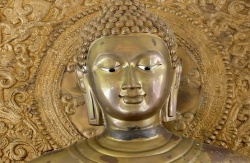The eighteen ways of describing the concept of 'emptiness'
The eighteen ways of describing the concept of emptiness' 1
(1) Adhyatma-sunyata - emptiness of the inner things, by which are meant the six vijnanas or consciousnesses, our psychological activities being thus looked upon as devoid of any permanency.
(2) Bahirdha-sunyata - emptiness of the outer things, by which are meant objects of the six consciousnesses, which objects are said to be empty because our visioning mind does not understand the reality behind them.
(3) Adhyatma-bahirdha-sunyata - emptiness of the inner-and-outer things, meaning that even the distinction in the concepts of inner and outer has no reality in itself and can be reversed at any time; this relativity is called emptiness.
(4) Sunyata-sunyata - emptiness of emptiness. The very idea of emptiness has no reality either, nor is it objectively attainable.
(5) Maha-sunyata - great emptiness, which has reference to the unreality of space considered as a container of objects with extension and location, and points to the esoteric significance of Space as the conscious and substantial totality of all that Is.
(6) Paramartha-sunyata - emptiness of the ultimate truth. By ultimate truth is meant the true be-ness of things, the state in which they truly are, apart from any temporary subjective form assumed by them. This state of the thing per se cannot be described in any manner whatsoever, as it precludes all attributes or qualities, although it Is; hence it is said to be from the human standpoint empty.
(7) Samskrita-sunyata - emptiness of composite things that have come into existence owing to causative conditions.
(8) Asamskrita-sunyata - emptiness of things which are not subject to causation (such as Space itself). The first of these two again postulates the fact that all things, outer and inner, are empty, unreal. The asamskrita exist in the mind only because they are contrasted with the samskrita. The unreality of the latter establishes the emptiness of the former.
(9) Atyanta-sunyata - ultimate emptiness, emphasizing the unconditional unreality of all objective things, beyond any possible qualification or causative dependence, and signifying that even the first veil of maya, spiritual as it is to us humans and long in duration, is nevertheless mayavi, because as a veil it is not the eternal essence from which it springs.
(10) Anavaragra-sunyata - emptiness of primordial beginning. When it is said that existence is beginning less, the mind clings to the idea of beginning lessness as something 1 Cf. essays in Zen Buddhism(Third series) by D.T.Suzuki pp. 222-228 the path of the search not of faith.
" To work for humanity is the first step" H.P. Blavatsky existing per se; therefore, in order to do away with this mental limitation, its emptiness is emphasized.
(11) Anavakara-sunyata - emptiness of dispersion or differentiation, having particular bearing upon the composite nature of all objective things, whether visible or invisible, whether physical or mental.
(12) Prakrita-sunyata - emptiness of primary or absolute nature, pointing to the fact that in no being or thing is there anything that could be termed an entirely independent, solitary, self-originating primary or absolute nature per se.
(13) Svalakshana-sunyata - emptiness of self-appearance; lakshana is the intelligible or understandable aspect of any individual entity, inseparably related to its primary nature. Fire, for instance, is intelligible through its heat; water through its fluidity, etc. By the emptiness of these 'selfaspects' or 'self-characteristics' is meant that any specific object has no permanent and irreducible characteristics to be considered as its own.
(14) Sarvadharma sya-sunyata - emptiness of all objects of sense and of thought, emptiness of the entire objective universe. All characterizations are impermanent, relative and phenomenal. Even our human idea of Reality, as being eternal, blissful, self-originating, self-governing, and devoid of any defilement, is in itself a limitation , and therefore is not Reality.
(15) Anupalambha-sunyata - emptiness of non-comprehension or of un-attainability. This implies that although Reality cannot be an object of relative thought, objectively comprehensible, and cannot therefore be said to be 'attainable,' yet it can be lived and directly realized through prajna.
(16) Abhava-sunyata - emptiness of non -being.
(17) Swabhava-sunyata - emptiness of self-nature
(18) Abhava-swabava-sunyata - emptiness of the non-being of selfnature.
These three terms point to the emptiness of such ideas as being and non-being, and the further emptiness of their contrast with each other.
For Reality lies beyond this distinction, and is independent of it.
Fountain-Source of Occultism page 649 - 651.
Theosophical University Press
The Theosophical Society (Pasadena) USA



